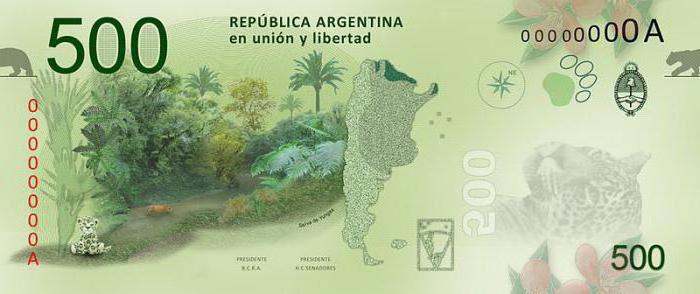The currency of Argentina is the peso. The name of the Argentine currency is quite common, because pesos are also found in the Dominican Republic, Guinea-Bissau, and the Philippines.
Stages of the development of the monetary system of Argentina
It should be noted that the national currency of Argentina has always had such a name, but from time to time the government was forced to carry out a monetary reform due to strong inflation. To determine the period of currency circulation in circulation, the following classification is introduced:
- peso of the national currency (this is the very first stage);
- peso of law No. 18188;
- Argentine Peso.

The currency of Argentina in its current form was issued by the Central Bank of the country in 1992, after another monetary reform.
Coins in Argentina
The National Bank of the country in 1992 issued coins in denominations from 1 centavo to 1 peso. I would like to talk about the appearance and technical characteristics of the coins. On the reverse of a coin with a face value of 1 centavo (issued before 2001), a laurel wreath was depicted. The diameter of the disc is 16.2 mm, the weight is 1.77 grams. Since the currency of Argentina has been very unstable for more than 10 years, now the smallest coin is 5 centavos. It is 1 mm larger in diameter and heavier by 0.48 grams. This brass-plated steel disc features a stylized sun.
10 centavo is a very popular coin today. Its diameter is 18.2 mm, and the weight is identical to the previous coin. The coat of arms of Argentina flaunts on the reverse of this masterpiece. As in the Ukrainian gradation, the value of coins after the “tens” is 25 centavos. This coin is much wider and heavier than the previous ones. Its diameter is 24.2 mm, and weight is already 6.1 grams. On metal money of 25 centavos, the town hall from the capital, Buenos Aires, is depicted. On a coin in denomination of 50 centavos - "House of Tucuman". It is 1 mm wider than the twenty-five, but lighter than it by 0.3 grams. Like all other coins, it is always minted from aluminum bronze.
Well, finally, we reached the face value of 1 peso. On the reverse is the emblem of the United Provinces of South America. The diameter of the ring is 23 mm, weight - 6.35 grams. In 2010, the Bank of Argentina introduced a new original coin of 2 pesos. Its rim is a ring made of an alloy of copper and nickel, and the middle is made of aluminum bronze. The picture is dedicated to the 200th anniversary of the May Revolution. The diameter of the coin is 24.5 mm, the weight is 7.2 g.

Argentina Currency: Banknotes
Today in circulation are paper money par value of 2, 5, 10, 20, 50 and 100 pesos. There are both old banknotes (1997-1999) and new ones (2015-2016).
The sizes of banknotes, unlike many other currencies of the world, are standard - 65 x 155 mm. Paper denominations differ from each other in coloring and photographs.
Paper in denominations of 2 pesos issued in blue and red colors. On one side is a photograph of the B. Miter Museum, and on the other a portrait of the same person. 5 pesos made in green and purple. On the obverse of the bill is a portrait of Jose de San Martin, and on the reverse is a fragment of the Glory monument in the city of Mendoza. The currency of Argentina with a face value of 10 pesos is a rectangle of brown-green color with a portrait of the famous figure Manuel Belgrano on the obverse and one of the monuments located in the city of Rosario.

Fans of red and yellow tones will definitely like a 20 peso bill with a portrait of Juan Manuel de Rosas and a photograph of a battle at sea at Obligado. "Fifty" in Argentina is yellow-violet. On the obverse flaunts a photograph of Domingo Faustino Sarmiento, and on the back we will see an image of the building of the Argentine government.The portrait of Julio Rocky is depicted on a 100 peso bill. It is made in violet-brown tones. The pattern on the back of the bill is very symbolic. Turning over a banknote, you can see the image of riders who arrived in new territories (conquerors).

Argentine currency: exchange rate to the ruble and other currencies
Peso is a very volatile monetary unit. Today, one also cannot talk about the absence of crisis trends. For example, from 2002 to 2008, the dollar / peso ratio was 4: 1, and in 2016 the rate is 14: 1. This is how the currency fluctuates in Argentina. To the ruble, the exchange rate also often changes. As of mid-2016, the weighted average is: 1 peso = 4.3519 rubles. The currency of Argentina is not much more expensive than the Ukrainian hryvnia (1 peso is 1.69 UAH). For a more complete picture of the "weight" of the monetary unit of this South American country, it is important to mention the exchange rate against the euro. As of August 8, 2016, 100 pesos is equal to 6.0798 euros.
